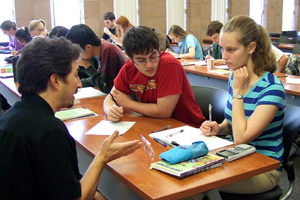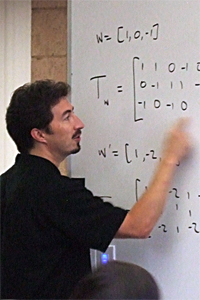Mathematics of Voting Proves Eye-opening
November 7, 2012As the nation reflects on yesterday’s presidential elections, students in Professor Mike Orrison’s class, “The Mathematics of Voting,” are using mathematics to see how voting procedures can affect election results. Their analysis reveals surprising, and sometimes troubling, facts about the fairness of voting systems. In fact, it has caused students to think differently about voting—from national elections to choosing a student body president.
Orrison’s class is learning how the winner of a given election can depend entirely on the procedures used to tally votes.
One of the examples they saw works roughly like this: start with a set of ballots in which voters have ranked three candidates, and tally the results using six common voting systems. In each of the six cases, the same ballots produce completely different outcomes.
For instance, if you use the current U.S. system for presidential elections—plurality— in which voters choose one favorite candidate, and the candidate with the most votes wins, you get a certain result. If you use a different voting system, such as “instant runoff,” in which voters’ choose a first, second and third choice, the same ballots might produce a different winner.
“It was extremely counterintuitive to see how some voting systems that I thought were perfectly reasonable could actually produce results that seemed unreasonable,” said Jennifer Rogers ’16. “It made me look deeper into what constitutes a ‘reasonable’ voting system, and what it really meant for a voting system to represent ‘the will of the voters.’”
 “I didn’t know there were so many possibilities to decide an outcome,” said Jazmin Ortiz ’16, an aspiring math major. “I thought it was about a winner and a loser. Through this course, I’ve seen that it varies so greatly over the method you use. It’s definitely changed my perspective on voting.”
“I didn’t know there were so many possibilities to decide an outcome,” said Jazmin Ortiz ’16, an aspiring math major. “I thought it was about a winner and a loser. Through this course, I’ve seen that it varies so greatly over the method you use. It’s definitely changed my perspective on voting.”
Students put the various voting systems used in the U.S. and Europe for national, local and informal elections to the test by evaluating them against a set of commonly accepted conditions for fair voting. These conditions, developed by economist Kenneth Arrow, include such criteria as: if all voters prefer candidate A over candidate B, candidate A should win; all votes should count equally; and, a group’s preference for candidate A over candidate B should not be affected by relative preferences for candidate C.
“After learning about several systems as well as Arrow’s Theorem, I was really taken aback by how flawed many of the voting systems that we use are,” said Alec Dunton ‘16. “The idea that ANY voting system will exhibit one or more undesirable properties was very hard to comprehend at first. After finishing a several page proof of Arrow’s theorem for a homework assignment, it became much more understandable.”
Applying math to analyze elections involving multiple candidates was particularly thought-provoking for several students.
“Math of Voting taught me how much third party candidates can affect an election even when they have no chance of winning,” said Maddie Weinstein ‘16. “Like Nader and Perot—these two candidates may have changed the outcomes of the presidential election they were in even when they only received a small percentage of the vote. Before this class I thought scrapping the Electoral College in favor of a simple popular vote could make for a reasonable voting system, but now I think we need a top-two primary if we want to choose a president that will make the greatest number of voters happy.”
More than one student was excited about applying math to a social phenomenon as complex and important as voting. It helped many understand where voting systems are vulnerable to arbitrariness or manipulation.
“We have empirical evidence of a voting system not reflecting the wishes of the electorate, which is something that always bothered me,“ said Jean Sung ‘16. “But before I came to this class I had no way to show that a particular system specifically violates a condition or criterion that we like. … We can use math to model the different voting systems and show which systems violate certain properties. It’s really exciting to use math to show the different voting systems in a concrete, quantitative way.”
The class has inspired students to think critically about the informal voting they often participate in such as electing a class president, choosing a dorm T-shirt design, or deciding which movie to see with a group of friends. They now think about how their vote will be used. If they are in a position to define the rules of voting, they consider how the voting procedures chosen will affect the outcome; or, how the system might be manipulated by strategic votes.
“Math of Voting has handed me a large supply of voting systems and taught me in what situations they work well,” Weinsten said. “If I ever have the power to help a small group make a decision, I’ll be able to suggest a way to make a choice that takes into account every person’s entire ranking of preferences.”
“This course is the perfect combination of rich mathematical ideas, pressing practical issues, and sometimes surprisingly emotional responses,” math Professor Mike Orrison said. “Given the prominent role that voting plays in how we make all sorts of decisions, it can be jarring to realize how complicated voting can be. In the end, I am absolutely certain that the students will emerge from the course with an empowering sense of confidence when it comes to weighing the pros and cons of the many voting systems they will undoubtedly encounter.”

